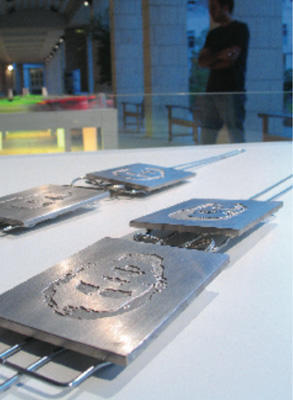
In September 2003, after a six-month delay due to the US-led invasion of Iraq, Beirut hosted a Food and Design exhibition. The public and the press escaped the summer heat and headed to Comptoir, a successful Lebanese shop and wine bar to view the installations. The history of this particular project dates back to the 2002 International Design Biennale in Saint-Étienne, France.
The organizers of the event, Table Rase which is a group that promotes design in the Middle East, chose food design as the theme because they wanted designers to work on a “mass appeal” subject. The objective of the exhibition was to increase the local population’s awareness of different types of art and also to stimulate Arab creativity using a novel medium. The selected designers were successful in proving that they can be innovative when it comes to preparing and presenting food. But more importantly, the designs provided a critical insight into how some artists view their culture and surroundings and how they translated this into the physical.
The week-long event also encompassed several lectures and seminars conducted by both regional and international players on the arts scene. Issues like the role of art and creativity in the Middle East and need for its development was at the forefront of discussions. While the exhibition, installations, and lectures mainly contributed to delight the senses of the visitors, it also set the stage for the acknowledgement of design in the region and coincided with the launch in Beirut of the ADAPO, or Association for Design and Architecture in the Middle East.
Bidoun spoke to one of the designers at the event. Ali Hussein Badr was born in 1967 in Kerbala, Iraq. He went to Yugoslavia to study, but by the time he received his diploma, Iraq was under sanctions and half of his family had disappeared under the former Ba’athist regime. Today, he is employed at an architectural firm in Switzerland, where he resides as a political refugee. Besides his work as an architect, he does some research on the interactions between politics, space and art.
Bidoun: Designed in 2002 for the Saint-Étienne Biennale, your meat grill “Let’s Meat” perfectly anticipated the events that occurred in 2003.
Ali Hussein Badr: More than ever! But I already had a strong feeling of the upcoming drama. As a matter of fact, my prototype is a multiple-meaning statement. First of all that the Iraqi people are like a piece of meat caught between two egocentric ambitions. They can’t do anything. They’re “cooked,” forever incapable of escaping from the game masters’ vice. Then, that the victim of war is never found on one side or the other, but in the middle. As to the executioners, they are united, mutually using pretexts to enslave their population. Finally, once the meat is cooked, what is left is the sad pleasure to cut into pieces the portrait of one of the two criminals. Me? I just leave them face to face. I don’t eat meat anyways.
Bidoun: What place is there today for Middle Eastern designers and creators in general?
AHB: Whether you are a film director, an architect, a designer or an artist, any creative individual in the Middle East must face several adversaries: a still very traditionalistic and community-oriented society, an economically and intellectually poor environment, a repressive government. But its role is essential because it is the only one to offer alternative views and to open tracks for reflections to society so that it may question its identity and its values. Its combat takes place in the universe of signs, language and senses. But he must also be heard, which is obviously quite difficult due to the absence of freedom of speech in Arab countries, and when you’re in forced exile like me. This is why every one of our interventions must be made with an undertaking spirit, but without losing the sense of derision…
Bidoun: Are you going to go back to Iraq, to Kerbala some day?
AHB: This is as if you asked me to go back into my mother’s womb; it was pretty difficult to get out of it. And I’m not sure to be very welcome when I go back. I have an Iraqi identity that has opened and become enriched since my passage in Belgrade and my stay in Switzerland. Just like Iraqi culture enriched from the contact of the Persians, Turks, Arabs, Kurds, Jews etc. But there are few people to admit this truth, especially in Kerbala. As a matter of fact, I will go back there, but incognito — to see, first. For the moment, I consider that there’s still a lot of work to do to modify the lamentable perception Westerners have of the Arabs, Persians, Turks and Muslims. Giving an alternative to the image conveyed by western media, this seems to me a constructive way of questioning the Iraqi identity.